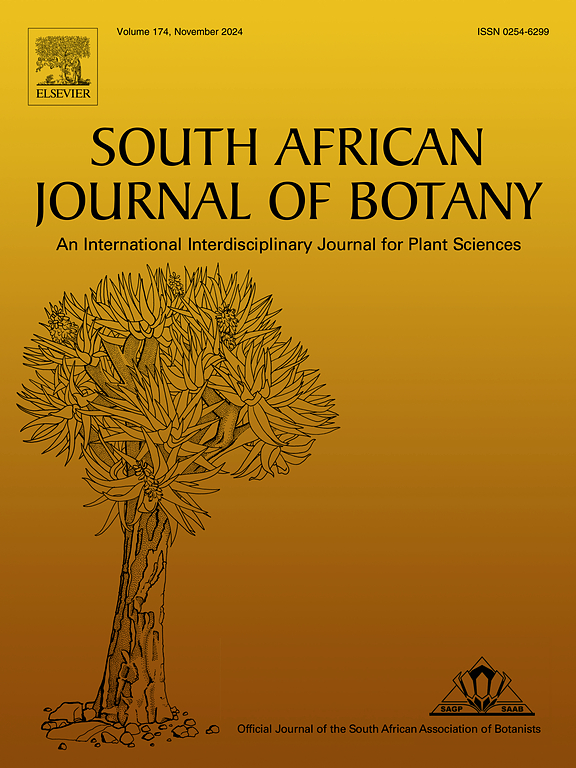三种不同酸乳杆菌的生物活性潜力:抗氧化能力、矿物质组成和元素状态
IF 2.7
3区 生物学
Q2 PLANT SCIENCES
引用次数: 0
摘要
长期以来,人们不仅认识到它的药用价值,而且还认识到它是有价值的膳食成分,因为它含有支持健康和营养的生物活性化合物。摘要本研究对冬青(R. alpinus)、冬青(R. obtusifolius L. subsp)叶片和花的抗氧化能力、酚类成分、矿物质含量和元素状态进行了评价。小扁豆和粗尾扁豆。horizontalis。通过FRAP、CUPRAC和DPPH测定抗氧化活性。采用HPLC-DAD(高效液相色谱-二极管阵列检测)测定酚类成分(25种酚类化合物)。采用电感耦合等离子体质谱(ICP-MS)测定宏量和微量营养成分,采用CHNS-O分析仪测定甲醇提取物的元素状态(C、H、N、S和O)。值得注意的是,山竹花具有最高的FRAP(138.62µmol Fe/g)和CUPRAC (0.44 mmol TEAC/g)值,以及最强的DPPH自由基清除能力(IC₅₀:0.15 mg/mL),而该品种的叶片具有最高的抗坏血酸含量。总酚含量在高山夜蛾花中达到最高(64.34 mg g⁻¹),而总黄酮含量在高山夜蛾叶中达到最高(17.7 mg g⁻¹)。在羟基苯甲酸中,3,4-羟基苯甲酸(6336 mg kg -⁻¹)在高山田径叶中占优势,而丙三酚(1553 mg kg -⁻¹)在马铃薯田径叶中占优势。horizontalis。高山田径花的橄榄苦苷含量最高(4289 mg kg⁻¹),而总羟基肉桂酸(3534 mg kg⁻¹)在tuberosus L. subsp中含量最高。horizontalis。此外,儿茶素(3667毫克公斤⁻¹)被确定为主要的类黄酮的叶子r . obtusifolius l .无性系种群。subalpinus。高山扁桃叶含有最多的锰(877.6µg kg⁻¹)和铁(287.5µg kg⁻¹),高山扁桃花含有最多的铜(817.8µg kg⁻¹)。块茎松茸的花。(8)含锌最多(856.4µg kg⁻¹)。此外,tuberosus L. subsp。它的叶子显示出显著的Mg (594 Mg 100 g⁻¹)和K (4320 Mg 100 g⁻¹)的含量,在叶子和花中都检测到高的Ca (1019 Mg 100 g⁻¹)。元素分析进一步表明,高山松花含碳量最高(46%),而晚秋松花含碳量最高(46%)。花中氢含量最高(6%)。根据这些结果,研究区分别为:高山田鼠、钝叶田鼠。和tuberosus subsp。Horizontalis不仅提供潜在的营养和药理益处,而且还表现出独特的化学分类特征。该研究提供了一个综合植物化学、元素和抗氧化特性的综合科学框架,支持了Rumex物种的分类分化,同时扩大了其在功能食品和药物中的潜在应用。本文章由计算机程序翻译,如有差异,请以英文原文为准。
The bioactive potential of three different Rumex species: Antioxidant capacity, mineral composition and elemental status
Rumex L. species have long been recognized not only for their medicinal properties but also as valuable dietary components, owing to the presence of bioactive compounds that support both health and nutrition. This study evaluated the antioxidant capacity, phenolic composition, mineral content, and elemental status in the leaves and flowers of R. alpinus, R. obtusifolius L. subsp. subalpinus, and R. tuberosus L. subsp. horizontalis. Antioxidant activities were determined by FRAP, CUPRAC, and DPPH assays. Phenolic composition (25 phenolic compounds) was determined by HPLC-DAD (high-performance liquid chromatography with diode-array detection). Macro and micro-nutrients were quantified through ICP-MS (inductively coupled plasma mass spectrometry), while the elemental status (C, H, N, S, and O) of methanolic extracts was measured by a CHNS-O analyzer. Notably, the flowers of R. alpinus exhibited the highest FRAP (138.62 µmol Fe/g) and CUPRAC (0.44 mmol TEAC/g) values, along with the strongest DPPH radical scavenging capacity (IC₅₀: 0.15 mg/mL), whereas the leaves of this species showed the highest ascorbic acid content. The total phenolic content reached its peak (64.34 mg g⁻¹) in R. alpinus flowers, while the highest total flavonoid level (17.7 mg g⁻¹) was detected in R. alpinus leaves. Among hydroxybenzoic acids, 3,4-hydroxybenzoic acid (6336 mg kg⁻¹) was predominant in R. alpinus leaves, and progallol (1553 mg kg⁻¹) prevailed in R. tuberosus L. subsp. horizontalis. The flowers of R. alpinus contained the highest oleuropein (4289 mg kg⁻¹), whereas total hydroxycinnamic acids (3534 mg kg⁻¹) were most abundant in R. tuberosus L. subsp. horizontalis. Furthermore, catechin (3667 mg kg⁻¹) was identified as the main flavonoid in the leaves of R. obtusifolius L. subsp. subalpinus. R. alpinus leaves had the greatest Mn (877.6 µg kg⁻¹) and Fe (287.5 µg kg⁻¹) levels, while R. alpinus flowers were richest in Cu (817.8 µg kg⁻¹). The flowers of R. tuberosus L. subsp. horizontalis contained the highest Zn (856.4 µg kg⁻¹). Additionally, R. tuberosus L. subsp. horizontalis leaves showed notable Mg (594 mg 100 g⁻¹) and K (4320 mg 100 g⁻¹) contents, and high Ca (1019 mg 100 g⁻¹) was detected in both its leaves and flowers. Elemental analysis further indicated that R. alpinus flowers had the highest carbon content (46 %), whereas R. tuberosus L. subsp. horizontalis flowers exhibited the highest hydrogen level (6 %). In light of these results, R. alpinus, R. obtusifolius subsp. subalpinus, and R. tuberosus subsp. horizontalis not only offer potential nutritional and pharmacological benefits but also exhibit distinct chemotaxonomic characteristics. This study provides a comprehensive scientific framework that integrates phytochemical, elemental, and antioxidant properties, supporting the taxonomic differentiation of Rumex species while expanding their potential applications in functional foods and medicine.
求助全文
通过发布文献求助,成功后即可免费获取论文全文。
去求助
来源期刊

South African Journal of Botany
生物-植物科学
CiteScore
5.20
自引率
9.70%
发文量
709
审稿时长
61 days
期刊介绍:
The South African Journal of Botany publishes original papers that deal with the classification, biodiversity, morphology, physiology, molecular biology, ecology, biotechnology, ethnobotany and other botanically related aspects of species that are of importance to southern Africa. Manuscripts dealing with significant new findings on other species of the world and general botanical principles will also be considered and are encouraged.
 求助内容:
求助内容: 应助结果提醒方式:
应助结果提醒方式:


